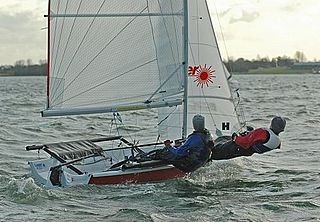Related Research Articles

Dinghy sailing is the activity of sailing small boats by using five essential controls:

The 49er and 49er FX is a two-handed skiff-type high-performance sailing dinghy. The two crew work on different roles with the helm making many tactical decisions, as well as steering, and the crew doing most of the sail control. Both of the crew are equipped with their own trapeze and sailing is done while cantilevered over the water to the fullest extent to balance against the sails.

The International 420 Dinghy is a sailing dinghy. The name refers to the boat length in centimeters, being 4.2 meters. The hull is fiberglass with internal buoyancy tanks. The 420 has a bermuda rig and an optional spinnaker and trapeze. It has a large sail-area-to-weight ratio, and is designed to plane easily. It can be rigged to be sailed single-handed or double-handed. The 420 is an International class recognized by the International Sailing Federation.

The Flying Dutchman (FD) is a 20-foot one-design high-performance two-person monohull racing dinghy. Developed in the early 1950s in the Netherlands, its large sail area per unit weight allow it to plane easily when sailing upwind. The boat utilizes a trapeze harness for the crew and hiking straps for the skipper to counterbalance the wind force on its sails. It made its Olympic debut at the 1960 Olympic Games.

The International 505 is a One-Design high-performance two-person monohull planing sailing dinghy, with spinnaker, utilising a trapeze for the crew.

In sailing, hiking is the action of moving the crew's body weight as far to windward (upwind) as possible, in order to decrease the extent the boat heels. By moving the crew's weight to windward, the moment of that force around the boat's center of buoyancy is increased. This opposes the heeling moment of the wind pushing sideways against the boat's sails. It is usually done by leaning over the edge of the boat as it heels. Some boats are fitted with equipment such as hiking straps and trapezes to make hiking more effective.

The Hobie Cat is a small sailing catamaran manufactured by the Hobie Cat Company. Hobie's line of products includes surfboards, sailboats, kayaks, stand-up paddle boards, and pedalboards, although the Hobie Cat Company is known worldwide for its catamarans. Hobie also designed a successful monohull, the Hobie 33.

The Manly Junior is a junior racing dinghy class popular in Sydney Australia. It was designed in 1959 for younger sailors and the length was originally designed so that the boat could be stored vertically downstairs inside Manly Yacht Club. To provide as much performance as possible in a short length, the designer, Ralph Tobias used a "snub" bow.

The Fireball is a British sailing dinghy that was designed by Peter Milne as a one-design racer and first built in 1962.

The Laser 4000 is a racing dinghy crewed by two persons. Its one-design weight-equalised system enables physically differing sailors to compete on a level playing field. It is most popular in Europe, particularly the UK, France and Italy.

The 18 ft Skiff is considered the fastest class of sailing skiffs. The class has a long history beginning with races on Sydney Harbour, Australia in 1892 and later in New Zealand. The boat has changed significantly since the early days, bringing in new technology as it became available. Because of the need of strength, agility and skill, the class is considered to be the top level of small boat sailing. In Australia this boat is called the "Aussie 18" due to its inherent connections to Australia. It is the fastest conventional non-foiling monohull on the yardstick rating, with a score of 675, coming only third after the Tornado and Inter 20.

The International Flying Junior or FJ is a sailing dinghy which was originally designed in 1955 in the Netherlands by renowned boat designer Van Essen and Olympic sailor Conrad Gülcher. The FJ was built to serve as a training boat for the then Olympic-class Flying Dutchman. The FJ has a beam of 4'11" and an overall sail area of 100 square feet (9.3 m2). These dimensions make the FJ an ideal class to teach young sailors the skills of boat handling and racing.

The Flying Eleven is an Australian boat designed as a high performance racing skiff suitable for 12- to 18-year-olds. High performance sailing is fast becoming the goal of a great many dinghy sailors with the appearance of 49ers as an Olympic class.The Flying Eleven is a logical step in the transition between junior classes such as the Manly Junior or Sabot and prepares young sailors for classes such as Cherubs, 420s, 470s, 29ers, Moths, 13s or even 49ers.

The 12 ft Skiff is a development dinghy class dating back to the early 20th century. It is sailed in Australia and New Zealand. It is 12 ft (3.7 m) in length, hence the name, and is a two-man boat. Both the crew and the helm are able to use the trapeze at the same time. It has an asymmetrical spinnaker and a jib, in addition to the mainsail.

The Cherub is a 12 feet long, high performance, two-person, planing dinghy first designed in 1951 in New Zealand by John Spencer. The class is a development class, allowing for significant variation in design between different boats within the rule framework. The minimum hull weight was originally 110 lbs.
The Norfolk Punt is a type of yacht, derived from the flat-bottomed gun punts that roamed the Broadland waters in the mid-to-late 19th century. However, at the turn of the 20th century, in order to get to and from the hunting grounds more quickly, the punters developed their highly unstable craft to carry a basic mast and sail for travelling with the wind. It is from these humble beginnings that one of the country’s most exciting and powerful racing dinghy classes was born.
A 16 ft Skiff is a class of three-person sailing dinghy with twin trapezes and a large asymmetrical spinnaker. The class is unique to Australia, where it is one of the most popular boats sailing with 95 boats registered in 12 clubs. The class has the largest fleet of high performance skiffs on the east coast of Australia. Due to the nature of only allowing two trapezes, the age of the sailors can vary between 15 and 60 years old, making it a versatile class of boat.
The RS700 is a single-handed racing dinghy built by RS Sailing and designed in 2000 by Nick Peters and Alex Southon as part of the RS series and built in 2001. It is raced in many sailing clubs around Britain, with a PY number of 850 and a D-PN of 73.3.

The Farr 3.7 is a one-person sailing dinghy designed by Bruce Farr in 1971. The design plans are sold by the 3.7 Class Owners Association and they are built by a mix of professionals and home built by amateurs. The 3.7 Class is recognised by Yachting New Zealand as a national class and yachts are sailed in New Zealand, Australia and Great Britain. Full sets of plans have been sold worldwide to a number of individuals with greatest numbers in Germany, Japan, USA, South Korea, Poland, France, Belgium.
The following outline is provided as an overview of and topical guide to sailing:
References
- ↑ Australian 14' Skate "home page"
- ↑ "history" Australian 14' Skate
- 1 2 Skate Sailing Australia "News 2014"
- 1 2 Chelsea Yacht Club, Victoria "history"